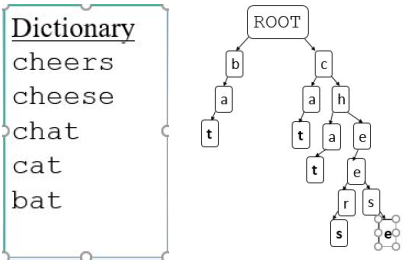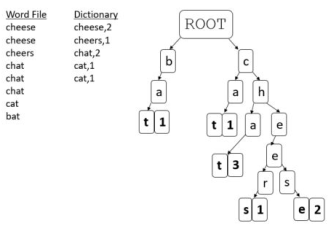Coursework Assignment 2: Word Auto Compleon with Tries
Assignment: Coursework Assignment 2: Word Auto Completion with Tries
|
Set by: |
Anthony Bagnall ([email protected]) Jason Lines ([email protected]) Tuesday 30th January 2020 35% |
Learning outcomes
Outcomes we aim for are: Increased experience of problem-solving and algorithm design and analysis; further experience of programming in Java; increased awareness of the importance of algorithm complexity.Specification
Overview
Your assignment involves developing a simplified system for auto-completion of words. The assignment is in three stages:1. read in a document of words, find the set of unique words to form a dictionary, count the occurrence of each word, then save the words and counts to file;
2. define a trie data structure for storing a prefix tree and design and implement algorithms to manipulate the trie; and
3. make a word completion system using the dictionary from part 1) and the data structure from part 2).
Your submission should include a document called report.pdf containing the required psuedo code and code listing.
I am obviously aware that there are trie implementations available online. I have no problem with you looking at them to help understand how to solve the problem, but clearly I do not want you copying code without understanding. Hence, if you do not adopt the required structure or your pseudocode does not match your code, you will lose marks. Do not add more than is asked for. If we suspect that you do not actually understand your implementation, we reserve the right to require you to walk us through your code and explain how it works.
Description
Part 1: Form a Dictionary and Word Frequency Count (20%)
Design an algorithm that takes as input a list of words and returns a dictionary of words and the frequency count of each word. Implement your algorithm as part of a class DictionaryFinder that fulfills the following process:1. read text document into a list of strings;
2. form a set of words that exist in the document and count the number of times each word occurs in a method called FormDictionary;
3. sort the words alphabetically; and4. write the words and associated frequency to file.
In your algorithm design, you may assume standard data structures are available and that you do not have to give pseudocode for operations such as add, remove and contains. For your implementation, you may use any of the built in data structures and algorithms available in Java. You should make the operation formDictionary as efficient as possible. The skeleton DictionaryMaker class on blackboard includes a method to read the words from a file into an ArrayList and an example of outputing a collection to file. You simply need to implement the methods formDictionary and saveToFile. A small example input and output text file (testDocument.csv and testDictionary.csv) are also on blackboard. Include a main method demonstrating the usage of your class. I am not interested in tesng your text parsing skills, so you may assume the input contains only lower case comma separated words with no punctuation, hyphenaon etc. Describe your algorithm in psuedocode in a section of report and perform an algorithm analysis. Don’t over think this, it should be prey simple to do this.
Part 2: Implement a Trie Data Structure (50%)
You need to design and implement a trie to hold string keys, including methods to manipulate the trie. You should assume that all the characters of any word input to the trie are lower case and restricted to contain the characters ‘a’ to ‘z’. Figure 1 gives and example dictionary and trie.
For each requirement, you should give a pseudo code algorithm in your report that is directly comparable to your implementaon. You do not need to give algorithmic descriptions of any secondary data structures you employ.
1. Define a TrieNode data structure and class that contains a list of offspring and a flag to indicate whether the node represents a complete word or not. Offspring should be stored in an array of fixed size 26 and the char values of the characters in the trie used as the index. So, for example, the letier ‘a’ is represented by the posion 0 in the offspring array. Hence, the root node for the trie shown in Figure 1 would contain a TrieNode array of size 26 with all null values except in posions 1 (‘b’) and 2 (‘c’).2. Define a Trie data structure and class with a TrieNode as a root.

Design and implement the following algorithms to manipulate the trie.
1. boolean add(String key): adds a key to the trie, creating any nodes required and returns true if add was successful (i.e. returns false if key is already in the trie, true otherwise).
2. boolean contains(String key): returns true if the word passed is in the trie as a whole word, not just as a prefix. So, for the example in Figure 1, contains("chee"), contains("afc") and contains("ba") would all return false, but contains("cheese") and contains("bat") would return true.
3. String outputBreadthFirstSearch(): returns a string representing a breadth first traversal. So, for example, for the tree shown in Figure 1, the method should output the string "bcaahttaetersse"
4. String outputDepthFirstSearch(): returns a string representing a pre order depth first traversal. So, for example, for the tree shown in Figure 1, the method should output the string "batcathateersse"
5. Trie getSubTrie(String prefix): returns a new trie rooted at the prefix, or null if the prefix is not present in this trie. So, for example, calling getSubTrie("ch") on the trie in Figure 1 would return the trie shown in Figure 2. Note the word flags are retained in the new Trie.
6. List getAllWords(): returns a list containing all words in the trie. So, for example, the trie shown in Figure 1 would return bat, cat, cheers, cheese, chat, whereas calling on the Trie in Figure 2 would return eers,eese,at. The order the words are returned in is unimportant, but you should make your algorithm getAllWords as efficient as possible.
I want you to follow the exact structure described above. You may add the odd small helper method and add extra atiributes, but do not make substantial changes. I am not interested in testing your understanding of programming 2 here, so do not make it generic, iterable etc. Again, I realise there are trie implementations available, so engineering you code will just evoke suspicion. method and add extra atiributes, but do not make substantial changes. I am not interested in testing your understanding of programming 2 here, so do not make it generic, iterable etc.

Figure 2: Trie resulting from calling getSubTrie("ch") on the trie shown in Figure 1
the data structures provided in the standard Java release. Include a main method in class Trie that demonstrates the functionality of your data structure and algorithms.
Part 3: Word Auto Completion Application (30%)
Your task is to adapt you your soluons to parts 1 and 2 to use as a basis for a prototype word compleon program. The challenge is, given a partially complete word, find the most likely complete words based on the word frequencies in the text file lotr.csv. You do not need to develop an interface or anything complicated. It should be a simple program that loads a set of searches, finds the best matches, displays the results to the standard output stream and also saves them to file. The basic use case is:1. Load all the queries file called queries.csv from the project directory.
2. For each query, find the best three matches (at most) with the most likely first, and with associated esmated probability of correctness. If words have equal probability, choose the first occurring word as determined by a breadth first search. Probabilities should be calculated from the frequencies (see example below).
3. Write the results into a file called matches.csv in exactly the specified format.
An test input and output file using the example in Figure 3 are provided.

To accomplish this task you need to:
1. form a diconary file of words and counts from the file lotr.csv (if you cannot complete part 1, you may use the file gollum.csv instead without penalty).
2. construct a trie from the diconary using your soluon from part 2 (if you cannot complete part 2, you may aempt a soluon based on built in Java data structures, although this will aract a penalty).
3. load the prefixs from lotrQueries.csv
4. for each prefix query
You may have to adapt your soluon to part 2 for this queson to include the frequency counts. If you do so, clone the code and call the class AutoCompletionTrie. Probabilities are based on relative frequencies of matches. So, for example, suppose we have the prefix hi and we are using the lotr diconary. We find the following matches and frequencies:4.1. Recover all words matching the prefix from the trie.4.2. Choose the three most frequent words and display to standard output.4.3. Write the results to lotrMatches.csv.
| Word | Frequency | Probability |
|
hidden high higher hill hills hillside him himself his hiss |
2 5 1 9 1 2 21 5 33 1 |
0.025 0.0625 0.0125 0.1125 0.0125 0.025 0.2625 0.0625 0.4125 0.0125 |
his (probability 0.4125)
him (probability 0.2625)
hill (probability 0.1125)
and output the following line to file hi,his,0.4125,him,0.2625,hill,0.1125 If the prefix is also a complete word in the trie it should be included in the calculaon and may be displayed. So, for the example above, the query “hill” should match hill, hills and hillside.
Include a pseudo code description of your algorithm in yourreport and implement your solution in a class AutoCompleon.java. Include the output in your report and generate lotrMatches.csv in the project directory.
Relationship to formative work
Please see the following lectures and lab exercises for background on each of the specifiedtasks:
• Describing algorithms: the lectures in week 2 introduced informal and formal descriptions of algorithms. Coursework 1 required algorithm design, descripon and analysis.
• Diconaries: Lecture 9 covered hash tables and diconaries. There is a relevant lab sheet.
• Trees and Tries: Lectures 10 and 11 covered trees and tries. There are relevant lab sheets.
Deliverables
You must submit a .zip file to BlackBoard using the submission point located in the Summative Assessment section. The .zip must contain the source files of your program, preferably in a Intellij project. The .zip file must also contain a .pdf file for your report (description of solutions to part 1-3 and a code listing). Please follow this link for a template report https://www.overleaf.com/read/wdrrnxknztkr Copy this project and use it as a template. There is help on overleaf on programming 2 blackboard.Plagiarism and collusion: Stackoverflow and other similar forums (such as the module discussion board) are valuable resources for learning and completing formative work. However, for assessed work such as this assignment, you may not post questions relating to coursework solutions in such forums. Using code from other sources/wrien by others without acknowledgement is plagiarism, which is not allowed (General Regulaon 18).
Resources
• Previous exercises: the lab exercises for hash tables, trees and tries will help, and the teaching assistants can offer direct support for these.• Discussion board: if you have clarificaon questions about what is required then please ask these questions on the Blackboard discussion board. This will enable other students to also benefit from the queson/answer. Please check that your question has not been asked previously before starting a new thread.
• Course text: Goodrich, M. T., Tamassia, R. (2005) Data Structures and Algorithms in Java, 4th edition, especially chapter 13.
Marking Scheme
1. Form a Dictionary and Word Frequency Count (20 marks, 7% of the overall module marks)2. Implement a Trie Data Structure (50 marks, 17.5% of the overall module marks)
3. Word Auto Completion Applicaon (30 marks, 10.5% of the overall module marks)
Total: 100 Marks, 35% of the overall module marks
2020-07-16